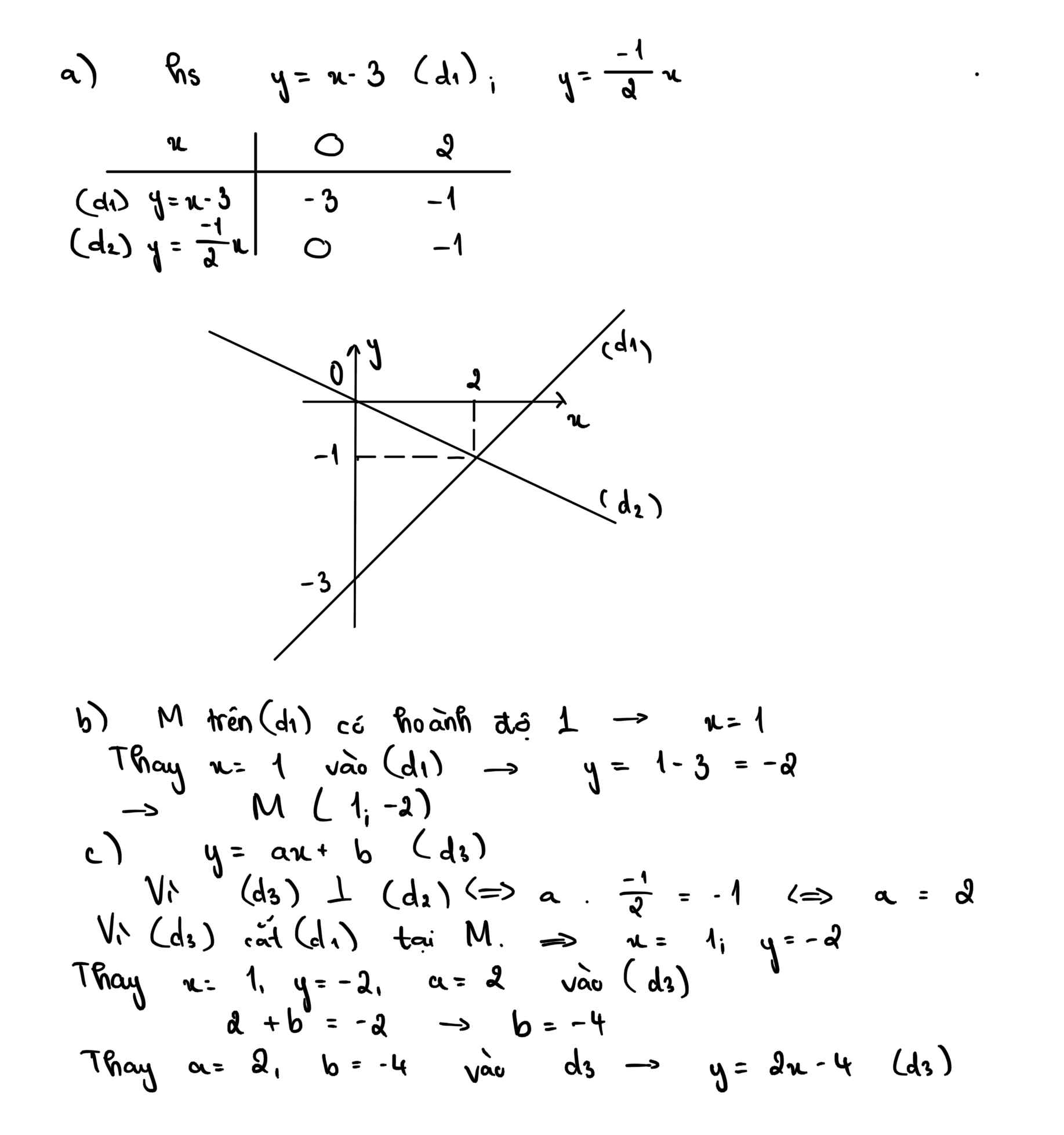Hãy nhập câu hỏi của bạn vào đây, nếu là tài khoản VIP, bạn sẽ được ưu tiên trả lời.

\(b,\text{PT hoành độ giao điểm: }-2x+5=x-1\Leftrightarrow x=2\Leftrightarrow y=1\Leftrightarrow A\left(2;1\right)\\ \text{Vậy }A\left(2;1\right)\text{ là giao điểm }\left(d_1\right)\text{ và }\left(d_2\right)\\ c,\text{Gọi }\left(d_3\right):y=ax+b\left(a\ne0\right)\text{ là đt cần tìm}\\ \left(d_3\right)\text{//}\left(d_1\right)\text{ và }M\left(-2;1\right)\in\left(d_3\right)\Leftrightarrow\left\{{}\begin{matrix}a=-2\\b\ne5\\-2a+b=1\end{matrix}\right.\Leftrightarrow\left\{{}\begin{matrix}a=-2\\b=-1\end{matrix}\right.\\ \Leftrightarrow\left(d_3\right):y=-2x-1\)

b) Ta có: (d2): \(y=\dfrac{-x}{3}-\dfrac{1}{2}\)
\(\Leftrightarrow y=\dfrac{-1}{3}x-\dfrac{1}{2}\)
Gọi A(xA;yA) là giao điểm của (d1) và (d2)
Hoành độ của A là:
\(\dfrac{-1}{3}x-\dfrac{1}{2}=2-x\)
\(\Leftrightarrow\dfrac{-1}{3}x-\dfrac{1}{2}-2+x=0\)
\(\Leftrightarrow\dfrac{2}{3}x-\dfrac{5}{2}=0\)
\(\Leftrightarrow\dfrac{2}{3}x=\dfrac{5}{2}\)
\(\Leftrightarrow x=\dfrac{5}{2}:\dfrac{2}{3}=\dfrac{5}{2}\cdot\dfrac{3}{2}=\dfrac{15}{4}\)
Thay \(x=\dfrac{15}{4}\) vào hàm số y=2-x, ta được:
\(y=2-\dfrac{15}{4}=\dfrac{8}{4}-\dfrac{15}{4}=-\dfrac{7}{4}\)
Vậy: \(A\left(\dfrac{15}{4};-\dfrac{7}{4}\right)\)

\(a,m=3\Leftrightarrow\left(d_1\right):y=2x+1\\ b,\text{Gọi PT cần tìm là }\left(d_2\right):y=ax+b\left(a\ne0\right)\\ \Leftrightarrow\left\{{}\begin{matrix}a=2\\b\ne1\end{matrix}\right.\Leftrightarrow\left(d_2\right):y=2x+b\\ \text{PT giao }Ox:y=0\Leftrightarrow x=-\dfrac{b}{2}\Leftrightarrow A\left(-\dfrac{b}{2};0\right)\Leftrightarrow OA=\left|\dfrac{b}{2}\right|\\ \text{PT giao }Oy:x=0\Leftrightarrow y=b\Leftrightarrow B\left(0;b\right)\Leftrightarrow OB=\left|b\right|\)
Gọi H là chân đường cao từ O tới \(\left(d_2\right)\Leftrightarrow OH=1\)
Áp dụng HTL: \(\dfrac{1}{OH^2}=\dfrac{1}{OA^2}+\dfrac{1}{OB^2}\)
\(\Leftrightarrow\dfrac{4}{b^2}+\dfrac{1}{b^2}=1\\ \Leftrightarrow\dfrac{5}{b^2}=1\Leftrightarrow b^2=5\Leftrightarrow b=\pm\sqrt{5}\left(tm\right)\)
Vậy \(\left(d_2\right)\) có dạng \(\left(d_2\right):y=2x+\sqrt{5}\) hoặc \(\left(d_2\right):y=2x-\sqrt{5}\)
\(c,\text{Gọi điểm cần tìm là }A\left(x_0;y_0\right)\\ \Leftrightarrow y_0=mx_0-x_0+m-2\\ \Leftrightarrow m\left(x_0+1\right)-\left(x_0+y_0+2\right)=0\\ \Leftrightarrow\left\{{}\begin{matrix}x_0+1=0\\x_0+y_0+2=0\end{matrix}\right.\Leftrightarrow\left\{{}\begin{matrix}x_0=-1\\y_0=-1\end{matrix}\right.\Leftrightarrow A\left(-1;-1\right)\\ \text{Vậy }A\left(-1;-1\right)\text{ là điểm cố định mà }\left(d\right)\text{ đi qua với mọi }m\)
\(\text{PT giao }Ox:y=0\Leftrightarrow x=\dfrac{2-m}{m-1}\Leftrightarrow A\left(\dfrac{2-m}{m-1};0\right)\Leftrightarrow OA=\left|\dfrac{m-2}{m-1}\right|\\ \text{PT giao }Oy:x=0\Leftrightarrow y=m-2\Leftrightarrow B\left(0;m-2\right)\Leftrightarrow OB=\left|m-2\right|\\ \text{Ta có }S_{OAB}=\dfrac{1}{2}OA\cdot OB=\dfrac{1}{2}\cdot\left|\dfrac{m-2}{m-1}\right|\cdot\left|m-2\right|\\ \Leftrightarrow S_{OAB}=\dfrac{\left(m-2\right)^2}{2\left|m-1\right|}\)
Đặt \(S_{OAB}=t\)
Với \(m\ge1\Leftrightarrow t=\dfrac{\left(m-2\right)^2}{2\left(m-1\right)}\Leftrightarrow2mt-2t=m^2-4m+4\)
\(\Leftrightarrow m^2-2m\left(2-t\right)+2t+4=0\)
PT có nghiệm \(\Leftrightarrow\Delta'=\left(2-t\right)^2-\left(2t+4\right)\ge0\)
\(\Leftrightarrow t^2-6t\ge0\Leftrightarrow t\left(t-6\right)\ge0\Leftrightarrow\left[{}\begin{matrix}t\le0\\t\ge6\end{matrix}\right.\left(1\right)\)
Với \(m< 1\Leftrightarrow t=\dfrac{\left(m-2\right)^2}{2\left(1-m\right)}\Leftrightarrow2t-2mt=m^2-4m+4\)
\(\Leftrightarrow m^2+2m\left(t-2\right)+4-2t=0\)
PT có nghiệm \(\Leftrightarrow\Delta'=\left(t-2\right)^2-\left(4-2t\right)\ge0\)
\(\Leftrightarrow t^2-2t\ge0\Leftrightarrow t\left(t-2\right)\ge0\Leftrightarrow\left[{}\begin{matrix}t\le0\\t\ge2\end{matrix}\right.\left(2\right)\)
\(\left(1\right)\left(2\right)\Leftrightarrow t\ge6\)
Vậy \(\left(S_{OAB}\right)_{min}=6\Leftrightarrow\dfrac{\left(m-2\right)^2}{2\left|m-1\right|}=6\)
\(\Leftrightarrow12\left|m-1\right|=m^2-4m+4\\ \Leftrightarrow\left[{}\begin{matrix}12\left(m-1\right)=m^2-4m+4\left(m\ge1\right)\\12\left(1-m\right)=m^2-4m+4\left(m< 1\right)\end{matrix}\right.\\ \Leftrightarrow\left[{}\begin{matrix}m^2-16m+16=0\\m^2+8m-8=0\end{matrix}\right.\Leftrightarrow\left[{}\begin{matrix}m=8\pm4\sqrt{3}\\m=-4\pm2\sqrt{6}\end{matrix}\right.\)

b) Vì A(xA;yA) là giao điểm của (D) và (D1) nên Hoành độ của A là nghiệm của phương trình hoành độ giao điểm có hai vế là hai hàm số của (D) và (D1)
hay \(-x-4=3x+2\)
\(\Leftrightarrow-x-4-3x-2=0\)
\(\Leftrightarrow-4x-6=0\)
\(\Leftrightarrow-4x=6\)
hay \(x=-\dfrac{3}{2}\)
Thay \(x=-\dfrac{3}{2}\) vào hàm số y=-x-4, ta được:
\(y=-\left(-\dfrac{3}{2}\right)-4=\dfrac{3}{2}-4=\dfrac{3}{2}-\dfrac{8}{2}=-\dfrac{5}{2}\)
Vậy: \(A\left(-\dfrac{3}{2};-\dfrac{5}{2}\right)\)
c) Vì (D2) song song với (D) nên a=-1
hay (D2): y=-x+b
Vì (D2) đi qua điểm B(-2;5)
nên Thay x=-2 và y=5 vào hàm số y=-x+b, ta được:
-(-2)+b=5
hay b=5-2=3
Vậy: (D2): y=-x+3
b) Vì A(xA;yA) là giao điểm của (D) và (D1) nên Hoành độ của A là nghiệm của phương trình hoành độ giao điểm có hai vế là hai hàm số của (D) và (D1)
hay \(-x-4=3x+2\)
\(\Leftrightarrow-x-4-3x-2=0\)
\(\Leftrightarrow-4x-6=0\)
\(\Leftrightarrow-4x=6\)
hay \(x=-\dfrac{3}{2}\)
Thay \(x=-\dfrac{3}{2}\) vào hàm số y=-x-4, ta được:
\(y=-\left(-\dfrac{3}{2}\right)-4=\dfrac{3}{2}-4=\dfrac{3}{2}-\dfrac{8}{2}=-\dfrac{5}{2}\)
Vậy: \(A\left(-\dfrac{3}{2};-\dfrac{5}{2}\right)\)
c) Vì (D2) song song với (D) nên a=-1
hay (D2): y=-x+b
Vì (D2) đi qua điểm B(-2;5)
nên Thay x=-2 và y=5 vào hàm số y=-x+b, ta được:
-(-2)+b=5
hay b=5-2=3
Vậy: (D2): y=-x+3

a, Hàm số \(\left(d_1\right)y=-2x+3\)
Cho \(y=0=>x=\dfrac{3}{2}\) ta được điểm \(\left(\dfrac{3}{2};0\right)\)
Cho \(x=0=>y=3\) ta được điểm \(\left(0;3\right)\)
Vẽ đồ thị hàm số \(\left(d_1\right)\) đi qua hai điểm trên
hàm số \(\left(d_2\right)y=x-1\)
Cho \(y=0=>x=1\) ta được điểm \(\left(1;0\right)\)
Cho \(x=0=>y=-1\) ta được điểm \(\left(0;-1\right)\)
Vẽ đồ thị hàm số \(\left(d_2\right)\) đi qua hai điểm trên
# Bạn có thể tự vẽ nhé !!
b, Tọa độ giao điểm \(\left(d_1\right);\left(d_2\right)\) là nghiệm của pt
\(-2x+3=x-1\\ =>-3x=-4\\ =>x=\dfrac{4}{3}\)
Thay \(x=\dfrac{4}{3}\) vào \(\left(d_2\right)\)
\(\Rightarrow y=\dfrac{4}{3}-1=\dfrac{1}{3}\)
Vậy tọa độ giao điểm là : \(\left(\dfrac{4}{3};\dfrac{1}{3}\right)\)
c, Giả sử \(\left(d_3\right)y=ax+b\)
\(\left(d_3\right)\) đi qua \(A\left(-2;1\right)\) và song song với đường thẳng \(\left(d_1\right)y=-2x+3\)
\(\Rightarrow\left\{{}\begin{matrix}4a+b=1\\a=-2;b\ne3\end{matrix}\right.\Rightarrow\left\{{}\begin{matrix}4.\left(-2\right)+b=1\\a=-2;b\ne3\end{matrix}\right.\Rightarrow\left\{{}\begin{matrix}b=9\left(t/m\right)\\a=-2\end{matrix}\right.\)
Vậy \(d_3:y=-2x+9\)
#Rinz
